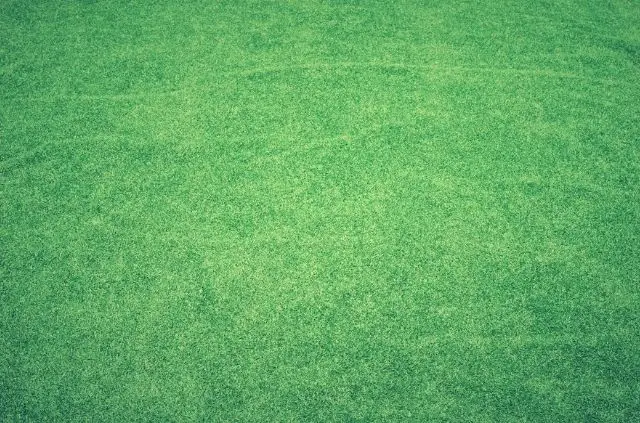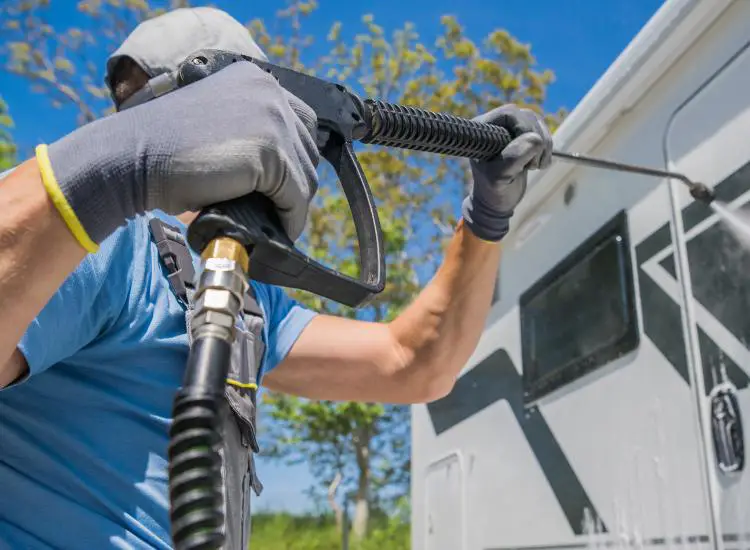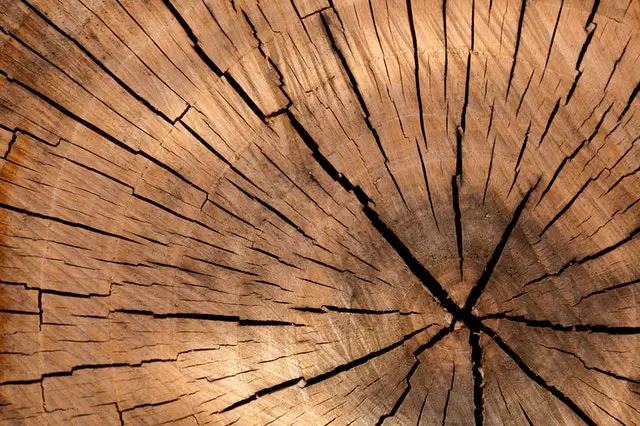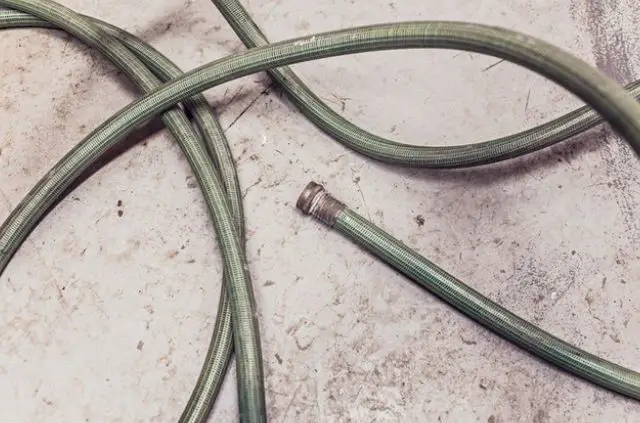Pressure Washer Loses Pressure (Solved)
When working correctly pressure washers are useful tools that can help clean houses, walkways, and cars. But what if the machine is barely letting out any water? Let’s talk about why a pressure washer loses pressure and how you can fix it.
There are a few things you can check, before taking the pressure washer to a small engine shop. This could potentially save you hundreds of dollars in repairs. The process is straightforward even if you don’t consider yourself a mechanical person. Try out each step below.
1. Test the System
In order to correctly diagnose the problem, you will need to locate the pump. A horizontal pump will stick out on one side of the pressure washer and they are generally easier to work on.
Some pumps sit below the engine, which make things more difficult. Make sure to hook everything up like you are about to use the pressure washer. Attach the garden hose at both ends, high pressure hose, and wand.
Pull the trigger and see if there is any water dripping out of the nozzle. Even with the motor turned off, there should be a small amount of water dispersing.
2. Clean the Nozzle
If there’s no water coming out from the wand, chances are there is a plug somewhere. The first place to check is the nozzle attachment located at the end of the wand.
Remove this tip and hold it up to the light, in order to see if any light is coming through. Unclog the hole if there isn’t any light.
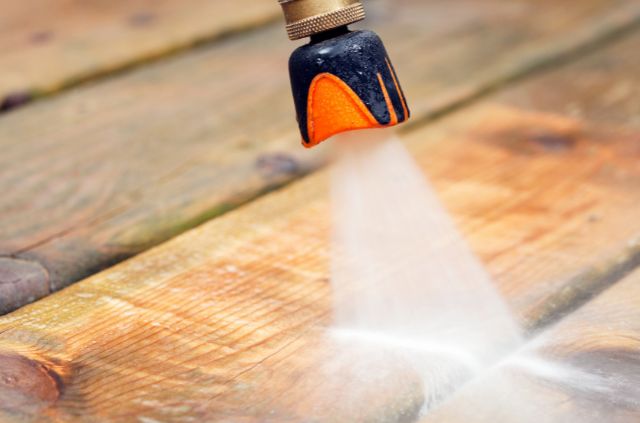
Occasionally a pebble, or piece of rust can clog the nozzle. If that’s the case you can use a small screwdriver, drill bit, or twist tie wire to remove it.
You could even use an air compressor to blow out the nozzle. If the contaminant won’t come out, you can always use another nozzle.
3. Inspect the Pump
If the nozzle doesn’t seem to be the problem, there’s another place you can check on the pressure washer. Examine the area where the high-pressure hose connects to the pump itself.
You can use a wrench to easily remove this part. The size wrench will depend on the make and model. Once the coupler has been removed you can unscrew the small section that connects to the high-pressure hose.
There will be a small spring and plunger that you will need to inspect, like you did with the nozzle. Hold this part up to the light and see if it is clogged with any debris.
Oftentimes this coupler is the biggest reason for losing pressure. There is a small rubber o-ring that seals the circumference and keeps everything working properly. This o-ring can easily break and block water flow between the pump and the hose. If that’s the case it won’t cost much to buy a new o-ring.
4. Examine the Unloader Valve
Try checking the unloader valve if your pressure washer has one. These can be found on most vertical pumps that are located on the side of the machine. You can easily identify the unloader valve from the red or black handle.
If this isn’t in the correct position, there won’t be any pressure. When you buy a new pressure washer it’s common for this handle to be loosened all the way.
So, when you start up the machine for the first time, it might not be as powerful as you thought. The unloader valve can also get loosened if it accidentally bumps into an object during transportation.
5. Replace Rusted Parts
There’s one more thing you can check if the unloader valve was set to high pressure. Underneath the red or black handle is a small metal spring. When you tighten the unloader valve it compresses this spring.
This spring is very thick and can be difficult to bend with your hands. Make sure to replace this part if there is any rust. This is very common if you live somewhere with high moisture and humidity.
Because the spring is made from metal, it can rust and break. Once this happens the unloader valve won’t be able to function properly and increase the pressure when in use.
6. Check the Water Supply
It’s easy to blame faulty parts on a pressure washer, but sometimes the problem might not even be in the machine. Check all the connections and hoses leading up to the pressure washer.

If everything looks right, look at the outlet on the side of your hose. This should be turned up all the way. Even if this outdoor outlet is in the correct position, there is probably another shut-off valve in your home.
If one of these valves is slightly or fully turned off, it will cause low water pressure. Older homes can also be the reason for low water pressure, as outdated fixtures can become a bottleneck.
7. Bring It to a Professional
If all of the above methods failed, it’s time to take the pump to a professional. Look for a small engine repair shop in your area that deals with pressure washers.
When you call they might ask for the year, make, model, and engine type of your pressure washer. Pressure washers generally have two different types of pumps: reciprocating pumps and rotary pumps.
Reciprocating pumps operate using pistons, plungers, or diaphragms. Rotary pumps on the other hand use gears, screws, lobes, or vanes.
How Nozzles Can Decrease Pressure
No Nozzle – Not having the nozzle tip properly connect to the wand will greatly reduce the amount of pressure. This is common when people buy used pressure washers, because they may not realize it comes with a nozzle. Make sure that the wand is connected to an unclogged nozzle attachment.
Incorrect Nozzle – Pressure washer nozzles range by their level of aggressiveness. A 0-degree will be the most extreme, as it has a very small opening. A soap nozzle will produce the least amount of pressure because it has a wider opening. Experiment with different tips if you’re looking to get more pressure.
Dirty Nozzle – As we mentioned above, a slightly dirty nozzle can completely block the amount of water in your pressure washer. This seems to be most common for people who use the same size nozzle each time. If you have no pressure with your regular nozzle, try cleaning it or swapping it out for another one.
Old Nozzle – If your pressure washer gets a lot of use, it’s probably time to inspect the nozzle tips. There is such a high amount of water that comes out of this small area and over time the hole can decrease in size. This is one of the most common reasons why a pressure washer loses pressure with age.
Conclusion
Pressure washers aren’t perfect machines. Sometimes they can stall, overheat, and even lose pressure. Most of the time this problem can be solved quickly and easily.
By following the above guide, you could save yourself hundreds of dollars in repair costs. But if you still find that your pressure washer isn’t working, try looking up the exact name and model.
Look for common issues associated with your pressure washer and see if anyone else has encountered a similar issue. If this doesn’t help, go ahead and take it to a small engine repair shop.
Search Terms
- Pressure washer loses pressure causes
- Pressure washer loses pressure fix

